With the November election looming, many teachers have been hunting for books that address some of the political questions that have been raised this year. While writing my new children’s book, Let Your Voice Be Heard: The Life and Times of Pete Seeger, I became aware of how few titles address issues of politics or social conscience. From the Children’s Book-A-Day Almanac, I’ve selected a dozen that can spark discussion about some of the broader issues of this campaign season.
Picture Books
Conflict Resolution
Click, Clack, Moo: Cows That Type. Doreen Cronin. Ill. Betsy Lewin. 2010. Little Simon.
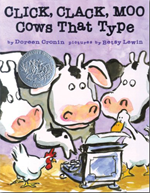 On June 23, 1868, the first American typewriter was patented by Luther Sholes. Beginning in 1937, the dairy industry has dedicated June as National Dairy Month, a time to call attention to the important role that milk and milk products play in our diets and the outstanding contributions made by dairy farmers. So how do these seemingly unrelated topics—typewriters, dairy farmers, and cows—connect to children’s books? In Click, Clack, Moo: Cows That Type, author Doreen Cronin, a lawyer by training, weaves these three elements together so perfectly that once you read the book, cows and typing will become intertwined forever. Farmer Brown is dumbstruck when his cows discover an old typewriter in the barn and begin pecking away at it: “All day long he hears click, clack, moo. Click, clack, moo. Clickety, clackety, moo.” Ultimately, typing gives the cows a means to communicate. Rather than placidly chewing their cuds, they take up a mission. Communication skills. Negotiating. Conflict resolution. These heavy matters are rarely presented in a picture book, particularly one that keeps readers laughing from the first page to last. Cronin’s text exemplifies two qualities of great picture book writing: lightness of touch and showing rather than telling. Both the text and art in Click, Clack, Moo come together perfectly to create a small gem that has readers ages 2 through 8 turning the pages to find out how everything is resolved.
On June 23, 1868, the first American typewriter was patented by Luther Sholes. Beginning in 1937, the dairy industry has dedicated June as National Dairy Month, a time to call attention to the important role that milk and milk products play in our diets and the outstanding contributions made by dairy farmers. So how do these seemingly unrelated topics—typewriters, dairy farmers, and cows—connect to children’s books? In Click, Clack, Moo: Cows That Type, author Doreen Cronin, a lawyer by training, weaves these three elements together so perfectly that once you read the book, cows and typing will become intertwined forever. Farmer Brown is dumbstruck when his cows discover an old typewriter in the barn and begin pecking away at it: “All day long he hears click, clack, moo. Click, clack, moo. Clickety, clackety, moo.” Ultimately, typing gives the cows a means to communicate. Rather than placidly chewing their cuds, they take up a mission. Communication skills. Negotiating. Conflict resolution. These heavy matters are rarely presented in a picture book, particularly one that keeps readers laughing from the first page to last. Cronin’s text exemplifies two qualities of great picture book writing: lightness of touch and showing rather than telling. Both the text and art in Click, Clack, Moo come together perfectly to create a small gem that has readers ages 2 through 8 turning the pages to find out how everything is resolved.
Farmer Duck. Martin Waddell. Ill. Helen Oxenbury. 1996. Candlewick.
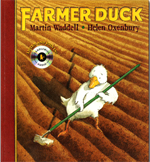 Poor Duck—he works tirelessly for a lazy, good-for-nothing farmer who spends all day in bed eating bonbons and reading the newspaper. Every now and then the man yells at duck, “How goes the work?” Duck takes care of the farm animals, washes dishes, irons. But no praise for Duck. And then one day, his barnyard friends unite behind him—and the animals take over the farm. Ultimately, the book explores the idea of fairness and can be paired with Click, Clack, Moo: Cows That Type to talk about power dynamics and taking control.
Poor Duck—he works tirelessly for a lazy, good-for-nothing farmer who spends all day in bed eating bonbons and reading the newspaper. Every now and then the man yells at duck, “How goes the work?” Duck takes care of the farm animals, washes dishes, irons. But no praise for Duck. And then one day, his barnyard friends unite behind him—and the animals take over the farm. Ultimately, the book explores the idea of fairness and can be paired with Click, Clack, Moo: Cows That Type to talk about power dynamics and taking control.
Activism
Imogene’s Last Stand. Candace Fleming Ill. Nancy Carpenter. 2014. Dragonfly.
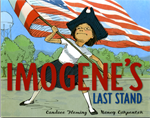 All of us live in communities rich with history—we just have to champion it. That message lies at the heart of Candace Fleming’s Imogene’s Last Stand. Imogene Tripp, the heroine, lives in Liddleville, New Hampshire, a town so small it “wasn’t even a speck on the state map.” Imogene loves history, and she constantly quotes from great historical speeches. As a kindergartner, she used show-and-tell to deliver the words of important women from the past. When older, she discovers the Liddleville Historical Society, an old house filled with antiques, “unloved and unwanted until Imogene pushed open its creaky front door.” After restoring the society to order, Imogene discovers that the mayor intends to tear the building down—but unfortunately for him, Imogene proves a worthy opponent, one who repeats John Paul Jones’s line “I have not yet begun to fight!” As Imogene works to have the house declared a national landmark, the book emphasizes that important events in history often occur in the smallest of towns. Although it addresses the serious topic of historical preservation, the book is executed with humor and panache.
All of us live in communities rich with history—we just have to champion it. That message lies at the heart of Candace Fleming’s Imogene’s Last Stand. Imogene Tripp, the heroine, lives in Liddleville, New Hampshire, a town so small it “wasn’t even a speck on the state map.” Imogene loves history, and she constantly quotes from great historical speeches. As a kindergartner, she used show-and-tell to deliver the words of important women from the past. When older, she discovers the Liddleville Historical Society, an old house filled with antiques, “unloved and unwanted until Imogene pushed open its creaky front door.” After restoring the society to order, Imogene discovers that the mayor intends to tear the building down—but unfortunately for him, Imogene proves a worthy opponent, one who repeats John Paul Jones’s line “I have not yet begun to fight!” As Imogene works to have the house declared a national landmark, the book emphasizes that important events in history often occur in the smallest of towns. Although it addresses the serious topic of historical preservation, the book is executed with humor and panache.
So You Want to Be President? Judith St. George. Ill. David Small. 2004. Philomel.
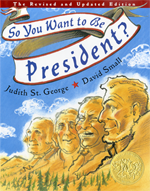 November is when Americans vote in national elections. November is also Picture Book Month, a time set aside to celebrate the need for picture books in the lives of children. Both causes merge in So You Want to Be President? by Judith St. George (revised in 2004), which both educates and entertains young people—just as good picture books should. Winner of the 2001 Caldecott Medal for David Small’s expressive and extremely funny illustrations, this book explores the backgrounds and personal characteristics of our nation’s presidents. Using telling details and fascinating quotes, St. George reveals one drawback of the job—people get mad at the president. In this witty and clever text, St. George shows the quirks and eccentricities of those who’ve occupied the Oval Office. Even readers who consider themselves quite savvy about American history will find a lot of surprises here. Abraham Lincoln, a poor dancer, once said to his future wife, Mary, “Miss Todd, I should like to dance with you in the worst way.” She later said to a friend, “He certainly did.” If you want to laugh about politics, rather than cry, pick up So You Want to Be President? It will give you, and the 7- to 12-year-olds that you share it with, a lot of reasons to smile.
November is when Americans vote in national elections. November is also Picture Book Month, a time set aside to celebrate the need for picture books in the lives of children. Both causes merge in So You Want to Be President? by Judith St. George (revised in 2004), which both educates and entertains young people—just as good picture books should. Winner of the 2001 Caldecott Medal for David Small’s expressive and extremely funny illustrations, this book explores the backgrounds and personal characteristics of our nation’s presidents. Using telling details and fascinating quotes, St. George reveals one drawback of the job—people get mad at the president. In this witty and clever text, St. George shows the quirks and eccentricities of those who’ve occupied the Oval Office. Even readers who consider themselves quite savvy about American history will find a lot of surprises here. Abraham Lincoln, a poor dancer, once said to his future wife, Mary, “Miss Todd, I should like to dance with you in the worst way.” She later said to a friend, “He certainly did.” If you want to laugh about politics, rather than cry, pick up So You Want to Be President? It will give you, and the 7- to 12-year-olds that you share it with, a lot of reasons to smile.
Novels
Immigration
Home of the Brave. Katherine Applegate. 2008. Square Fish.
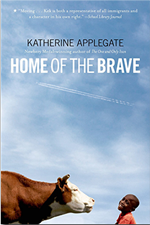 For me, Home of the Brave remains one of the most compelling books ever written for children about the immigrant experience. In this easy-to-read, imminently accessible novel for ages 10–14, Applegate creates one of fiction’s most compelling characters—Kek, a fifth-grade boy who has just arrived as a refugee from Sudan to live in Minnesota. In the civil war that ravaged his country, Kek lost his father and brother, and his mother remains missing. So like many of the refugees from his area, he was brought to Minnesota to live with his aunt and cousin. Everything about this strange new world, including the biting, terrible snow, confuses young Kek. He struggles with the strange sounds of a new language. But as Kek struggles with the unfamiliar, he finds one thing in the landscape he can hold on to—an old cow that has seen better days. This is one book about the immigration experience that has been created in a way that children can understand and respond to. Young readers over the years have understood Kek’s devotion to a cow, that reminds him of his life before America. In this character-driven book, Kek pulls readers along with his touching and painful story, his hope for a better life, and his assimilation into his new land. And so in the final chapter, when Kek is reunited with his mother, the last words of the book ring true—“Mama, I say, / welcome home.”
For me, Home of the Brave remains one of the most compelling books ever written for children about the immigrant experience. In this easy-to-read, imminently accessible novel for ages 10–14, Applegate creates one of fiction’s most compelling characters—Kek, a fifth-grade boy who has just arrived as a refugee from Sudan to live in Minnesota. In the civil war that ravaged his country, Kek lost his father and brother, and his mother remains missing. So like many of the refugees from his area, he was brought to Minnesota to live with his aunt and cousin. Everything about this strange new world, including the biting, terrible snow, confuses young Kek. He struggles with the strange sounds of a new language. But as Kek struggles with the unfamiliar, he finds one thing in the landscape he can hold on to—an old cow that has seen better days. This is one book about the immigration experience that has been created in a way that children can understand and respond to. Young readers over the years have understood Kek’s devotion to a cow, that reminds him of his life before America. In this character-driven book, Kek pulls readers along with his touching and painful story, his hope for a better life, and his assimilation into his new land. And so in the final chapter, when Kek is reunited with his mother, the last words of the book ring true—“Mama, I say, / welcome home.”
Activism and Changing Laws
Hoot. Carl Hiaasen. 2005. Yearling.
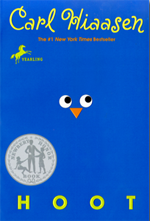 When I think of books set in Florida, Carl Hiaasen’s Newbery Honor Book Hoot, an exciting, page-turning mystery, immediately comes to mind. Roy Eberhardt, new kid in town, has arrived from Montana to Coconut Grove, FL. Because his father works for the Department of Justice and moves frequently for his job, Roy knows the routine—eating by himself, isolation, and bullies waiting to push him around. In fact, the book begins with the local bully, Dana Matherson, squashing Roy’s face against the bus window. While Dana is holding his head against the glass, Roy sees a towheaded boy recklessly running barefoot through the Florida landscape. When Roy decides to find this boy, nicknamed Mullet Fingers because he can catch the fish with his bare hands, Roy discovers that a new pancake house is about to be built over the dens of some extremely cute and very tiny burrowing owls. To save these small members of the biological community, Mullet Fingers has been engaging in ecoterrorism. Soon Roy and Mullet Finger’s sister, Beatrice, get swept up in Mullet Fingers’s obsession. Rather than participate in ecoterrorism, Roy decides to rely on the law and convinces his classmates to fight for the life of these owls and their babies. Not only does this engaging story explore the issues of endangered species and biological diversity, it also shows young people taking action. A perfect choice for 8- to 14-year-olds, the book often appeals as well to fans of Hiaasen’s adult mysteries. After all, a well-written story, with something to say, can appeal to people of many generations.
When I think of books set in Florida, Carl Hiaasen’s Newbery Honor Book Hoot, an exciting, page-turning mystery, immediately comes to mind. Roy Eberhardt, new kid in town, has arrived from Montana to Coconut Grove, FL. Because his father works for the Department of Justice and moves frequently for his job, Roy knows the routine—eating by himself, isolation, and bullies waiting to push him around. In fact, the book begins with the local bully, Dana Matherson, squashing Roy’s face against the bus window. While Dana is holding his head against the glass, Roy sees a towheaded boy recklessly running barefoot through the Florida landscape. When Roy decides to find this boy, nicknamed Mullet Fingers because he can catch the fish with his bare hands, Roy discovers that a new pancake house is about to be built over the dens of some extremely cute and very tiny burrowing owls. To save these small members of the biological community, Mullet Fingers has been engaging in ecoterrorism. Soon Roy and Mullet Finger’s sister, Beatrice, get swept up in Mullet Fingers’s obsession. Rather than participate in ecoterrorism, Roy decides to rely on the law and convinces his classmates to fight for the life of these owls and their babies. Not only does this engaging story explore the issues of endangered species and biological diversity, it also shows young people taking action. A perfect choice for 8- to 14-year-olds, the book often appeals as well to fans of Hiaasen’s adult mysteries. After all, a well-written story, with something to say, can appeal to people of many generations.
Media Spin
Nothing But the Truth. Avi. 2010. Scholastic.
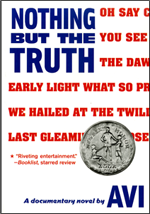 Truth, of course, is a slippery thing. What seems true to one person does not appear that way to another. One of our best novels for 10- to 14-year-olds, published in 1991 and already a classic, explores the issues of what is true, what is false, and what is misleading. In Avi’s Nothing But the Truth, ninth grader Phillip Malloy faces problems both at school and at home. His only release comes in running and in his dreams of making the track team. But a “D” in English, from veteran teacher Margaret Narwin, ends his quest—although the track coach suggests that Phillip simply go to the teacher and see if he can make up work. Phillip takes another approach—goading her. In her home room, when “The Star-Spangled Banner” is played “for respectful silent attention” over the public announcement system, Phillip starts to hum. After this continues and he refuses to stop, Ms. Narwin sends him to the vice principal, who eventually suspends him for repeated incidents of disrespect. Then Phillip and his father talk to the press—about the unpatriotic nature of the school. At this point, the media coverage all over the country causes the situation to spiral out of control. Well-written, well-paced, and provocative, Nothing But the Truth works brilliantly when read by a group—because everyone will come to a slightly different understanding of the events, depending on how he or she reads the evidence. Avi’s Nothing But the Truth is an engaging story, but it also causes readers to think about truth, lies, and the consequences.
Truth, of course, is a slippery thing. What seems true to one person does not appear that way to another. One of our best novels for 10- to 14-year-olds, published in 1991 and already a classic, explores the issues of what is true, what is false, and what is misleading. In Avi’s Nothing But the Truth, ninth grader Phillip Malloy faces problems both at school and at home. His only release comes in running and in his dreams of making the track team. But a “D” in English, from veteran teacher Margaret Narwin, ends his quest—although the track coach suggests that Phillip simply go to the teacher and see if he can make up work. Phillip takes another approach—goading her. In her home room, when “The Star-Spangled Banner” is played “for respectful silent attention” over the public announcement system, Phillip starts to hum. After this continues and he refuses to stop, Ms. Narwin sends him to the vice principal, who eventually suspends him for repeated incidents of disrespect. Then Phillip and his father talk to the press—about the unpatriotic nature of the school. At this point, the media coverage all over the country causes the situation to spiral out of control. Well-written, well-paced, and provocative, Nothing But the Truth works brilliantly when read by a group—because everyone will come to a slightly different understanding of the events, depending on how he or she reads the evidence. Avi’s Nothing But the Truth is an engaging story, but it also causes readers to think about truth, lies, and the consequences.
Political Protest
One Crazy Summer. Rita Williams-Garcia. 2010. Amistad.
 In One Crazy Summer, Rita Williams-Garcia has created a powerful book that explores a period in history while it pulls in young readers because of its engaging characters. In the summer of 1968, three sisters—Delphine, age 11, Vonetta, and Fern—find themselves living for 28 days with their mother, Cecile, in Oakland, CA. She had abandoned all of them as children and does not seem particularly excited to see them in her living space. A poet and an activist, Cecile (called Nzila by the Black Panthers) forbids them entry to her kitchen and wants them out of the way all day. Delphine, the oldest and the narrator of the saga, takes things in her own hands, caring for her sisters. In order to obtain breakfast, they spend their days at a summer camp sponsored by the Black Panthers, who provide food and education to those in the community. Although at first they are dismissive of what they hear at camp, the girls begin to comprehend the message of activism preached there. In this character-driven novel, Rita Williams-Garcia brings to life the community of Oakland and the issues of the 1960s. She incorporates a lot of humor into these serious subjects. As the Brooklyn girls respond to utterly new teachings in classes, they are not beyond letting members of the Black Panthers know that they “didn’t come for the revolution. We came for breakfast.” Because the book remains so true to an 11-year-old’s point of view, and because in the end, Delphine finally gets what she had traveled all those miles to find—the acceptance of her mother—the story works as a family saga with history interwoven.
In One Crazy Summer, Rita Williams-Garcia has created a powerful book that explores a period in history while it pulls in young readers because of its engaging characters. In the summer of 1968, three sisters—Delphine, age 11, Vonetta, and Fern—find themselves living for 28 days with their mother, Cecile, in Oakland, CA. She had abandoned all of them as children and does not seem particularly excited to see them in her living space. A poet and an activist, Cecile (called Nzila by the Black Panthers) forbids them entry to her kitchen and wants them out of the way all day. Delphine, the oldest and the narrator of the saga, takes things in her own hands, caring for her sisters. In order to obtain breakfast, they spend their days at a summer camp sponsored by the Black Panthers, who provide food and education to those in the community. Although at first they are dismissive of what they hear at camp, the girls begin to comprehend the message of activism preached there. In this character-driven novel, Rita Williams-Garcia brings to life the community of Oakland and the issues of the 1960s. She incorporates a lot of humor into these serious subjects. As the Brooklyn girls respond to utterly new teachings in classes, they are not beyond letting members of the Black Panthers know that they “didn’t come for the revolution. We came for breakfast.” Because the book remains so true to an 11-year-old’s point of view, and because in the end, Delphine finally gets what she had traveled all those miles to find—the acceptance of her mother—the story works as a family saga with history interwoven.
Suffragettes
The Cure for Dreaming. Cat Winters. 2016. Harry N. Abrams.
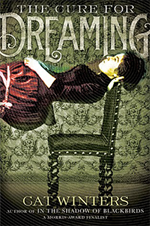 I want to sing the praises of the second novel by Cat Winters, The Cure for Dreaming. Now, I have been an active part of the children’s book world since 1970. And then, as now, nothing makes me more excited than when I find a new creative voice, someone who combines original material with a compelling writing style. Hence I was thrilled to read this book by Cat Winters, one of the Morris Awards nominees for new talent for In the Shadow of Blackbirds. In her second novel, she has brought together seemingly disparate elements—hypnotism and the Women’s Suffragette Movement—in a page-turning, exciting work of historical fiction for readers ages 11 through 14. The protagonist, Olivia Mead, is one of the most appealing I have encountered in recent fiction. A young girl living in Portland, OR, in 1900, Olivia has taken up the cause of women’s suffrage (the Western part of the United States, in fact, gave women the vote long before 1920). But Olivia’s passion for women’s rights conflicts with her father’s stern and unbending sense of a woman’s place in the household. The story begins in a theater, when a traveling hypnotist, Henri Reverie, selects Olivia as his subject for experimentation. She proves particularly susceptible to his craft, remembering little of the events that occurred while she was under his spell. Eventually Olivia’s father comes up with a demonic plan: He wants Henri to hypnotize Olivia to make her repulsed by the ideas of the suffragettes. Weaving multiple plot strands together and creating a vivid sense of the time when women fought to express their views, Cat Winters tells a compelling, truly mesmerizing story.
I want to sing the praises of the second novel by Cat Winters, The Cure for Dreaming. Now, I have been an active part of the children’s book world since 1970. And then, as now, nothing makes me more excited than when I find a new creative voice, someone who combines original material with a compelling writing style. Hence I was thrilled to read this book by Cat Winters, one of the Morris Awards nominees for new talent for In the Shadow of Blackbirds. In her second novel, she has brought together seemingly disparate elements—hypnotism and the Women’s Suffragette Movement—in a page-turning, exciting work of historical fiction for readers ages 11 through 14. The protagonist, Olivia Mead, is one of the most appealing I have encountered in recent fiction. A young girl living in Portland, OR, in 1900, Olivia has taken up the cause of women’s suffrage (the Western part of the United States, in fact, gave women the vote long before 1920). But Olivia’s passion for women’s rights conflicts with her father’s stern and unbending sense of a woman’s place in the household. The story begins in a theater, when a traveling hypnotist, Henri Reverie, selects Olivia as his subject for experimentation. She proves particularly susceptible to his craft, remembering little of the events that occurred while she was under his spell. Eventually Olivia’s father comes up with a demonic plan: He wants Henri to hypnotize Olivia to make her repulsed by the ideas of the suffragettes. Weaving multiple plot strands together and creating a vivid sense of the time when women fought to express their views, Cat Winters tells a compelling, truly mesmerizing story.
Immigration
The Arrival. Shaun Tan. 2007. Arthur A. Levine.
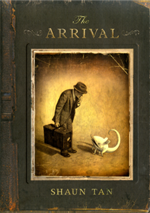 Except for Native Americans, the United States is a nation of immigrants. Consequently, hundreds of books for children present the experience of our ancestors from different perspectives. But none enable readers to experience the emotions of an immigrant to a strange country as brilliantly as Shaun Tan’s The Arrival. In this graphic novel, readers follow the story, presented without words, of a lone immigrant, who leaves his wife, daughter, and home, and travels by steamship to a new land. Huddled together with other passengers, he eventually sees his destination, but everything looks bizarre. Even the pets look like they might best be avoided. The language used on buildings and signs perplexes both the immigrant and the reader. Eventually he obtains a job hanging posters but turns them upside down until corrected. Because the reader is always viewing the scene from the immigrant’s eyes, he or she experiences this strange new land just as the man does. The Arrival allows viewers to imagine visually how the world appeared to immigrant ancestors, and it unfolds history in an immediate and striking way. Some fifth- through eighth-grade teachers have integrated the title into immigration units; others have pulled the book into writing classes, so students can tell their own interpretation of the story. Because the entire narrative occurs in the art, there are as many versions of what is happening as there are readers. Like Art Spiegelman’s graphic novel Maus, The Arrival can be appreciated both for its artistry and its social and political content.
Except for Native Americans, the United States is a nation of immigrants. Consequently, hundreds of books for children present the experience of our ancestors from different perspectives. But none enable readers to experience the emotions of an immigrant to a strange country as brilliantly as Shaun Tan’s The Arrival. In this graphic novel, readers follow the story, presented without words, of a lone immigrant, who leaves his wife, daughter, and home, and travels by steamship to a new land. Huddled together with other passengers, he eventually sees his destination, but everything looks bizarre. Even the pets look like they might best be avoided. The language used on buildings and signs perplexes both the immigrant and the reader. Eventually he obtains a job hanging posters but turns them upside down until corrected. Because the reader is always viewing the scene from the immigrant’s eyes, he or she experiences this strange new land just as the man does. The Arrival allows viewers to imagine visually how the world appeared to immigrant ancestors, and it unfolds history in an immediate and striking way. Some fifth- through eighth-grade teachers have integrated the title into immigration units; others have pulled the book into writing classes, so students can tell their own interpretation of the story. Because the entire narrative occurs in the art, there are as many versions of what is happening as there are readers. Like Art Spiegelman’s graphic novel Maus, The Arrival can be appreciated both for its artistry and its social and political content.
Nonfiction
Activism
Claudette Colvin: Twice Toward Justice. Phillip Hoose. 2009. Farrar Straus & Giroux.
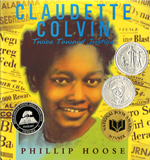 A native of Birmingham, AL, Claudette Colvin was named after the popular movie star Claudette Colbert. A rebellious teenager, she possessed a bit more courage than her peers. On March 2, 1955, in her high school in Montgomery, AL, she had been studying the Constitution of the United States. Going home that day, this young black woman did the unthinkable. When the bus driver yelled for her to yield her seat to a white woman, she refused to get up. “I was thinking. Why should I have to get up just because a driver tells me to, or just because I’m black? Right then, I decided I wasn’t gonna take it anymore. I hadn’t planned it out, but my decision was built on a lifetime of nasty experiences.” Of course, in the South at this time, she was expected, even required, to defer to whites. Even when confronted by policemen, Claudette shouted, “It’s my Constitutional right to sit here as much as that lady. I paid my fare!” In Claudette Colvin: Twice Toward Justice, winner of the National Book Award, author Phillip Hoose presents the life story of this unsung heroine of the Civil Rights Movement. Since the publication of his book, We Were There, Too! Young People in U.S. History, Phillip Hoose has been exploring how teenagers can make a difference in the world. In Claudette Colvin, he brings to life one very special young woman, who truly made a difference in the Civil Rights Movement.
A native of Birmingham, AL, Claudette Colvin was named after the popular movie star Claudette Colbert. A rebellious teenager, she possessed a bit more courage than her peers. On March 2, 1955, in her high school in Montgomery, AL, she had been studying the Constitution of the United States. Going home that day, this young black woman did the unthinkable. When the bus driver yelled for her to yield her seat to a white woman, she refused to get up. “I was thinking. Why should I have to get up just because a driver tells me to, or just because I’m black? Right then, I decided I wasn’t gonna take it anymore. I hadn’t planned it out, but my decision was built on a lifetime of nasty experiences.” Of course, in the South at this time, she was expected, even required, to defer to whites. Even when confronted by policemen, Claudette shouted, “It’s my Constitutional right to sit here as much as that lady. I paid my fare!” In Claudette Colvin: Twice Toward Justice, winner of the National Book Award, author Phillip Hoose presents the life story of this unsung heroine of the Civil Rights Movement. Since the publication of his book, We Were There, Too! Young People in U.S. History, Phillip Hoose has been exploring how teenagers can make a difference in the world. In Claudette Colvin, he brings to life one very special young woman, who truly made a difference in the Civil Rights Movement.
The Rise and Fall of Senator Joe McCarthy. James Cross Giblin. 2009. Clarion.
 The fearful ’50s, as they are sometimes called, can be difficult to describe to young people—who have not, after all, grown up believing Communism is the greatest threat to America. In The Rise and Fall of Senator Joe McCarthy, James Cross Giblin brilliantly re-creates this period and the complex and disturbing character of McCarthy for readers ages 11 through 18. He makes it possible for the young to understand the meaning of the word McCarthyism—guilt by association and unfounded accusation. From an initial cartoon of the period showing McCarthy signing legislation in the White House while President Eisenhower looks on, to the final notes about what happened to those covered in the book, Giblin provides an in-depth analysis of the events and personalities. In his final chapter he poses the question “Another McCarthy?” Can another dangerous leader rise up in the American landscape? Because of the thoroughness of the coverage, The Rise and Fall of Senator Joe McCarthy is ideal for thoughtful young readers trying to understand the politics of another era.
The fearful ’50s, as they are sometimes called, can be difficult to describe to young people—who have not, after all, grown up believing Communism is the greatest threat to America. In The Rise and Fall of Senator Joe McCarthy, James Cross Giblin brilliantly re-creates this period and the complex and disturbing character of McCarthy for readers ages 11 through 18. He makes it possible for the young to understand the meaning of the word McCarthyism—guilt by association and unfounded accusation. From an initial cartoon of the period showing McCarthy signing legislation in the White House while President Eisenhower looks on, to the final notes about what happened to those covered in the book, Giblin provides an in-depth analysis of the events and personalities. In his final chapter he poses the question “Another McCarthy?” Can another dangerous leader rise up in the American landscape? Because of the thoroughness of the coverage, The Rise and Fall of Senator Joe McCarthy is ideal for thoughtful young readers trying to understand the politics of another era.
Anita Silvey has served both as the editor of The Horn Book Magazine and as a publisher of a major children's book imprint. She is the author of several books, including Henry Knox: Bookseller, Soldier, Patriot and I’ll Pass for Your Comrade: Women Soldiers in the Civil War. The Children’s Book-a-Day Almanac, is an interactive website she describes as a “daily love letter to a book or author,” with each entry offering a glimpse into the story behind the story. Her columns are culled from the reviews on her website.